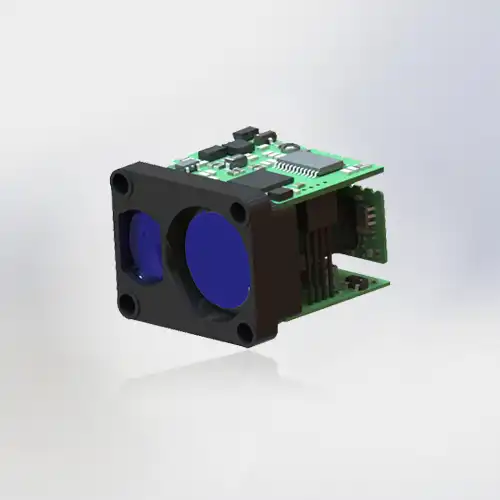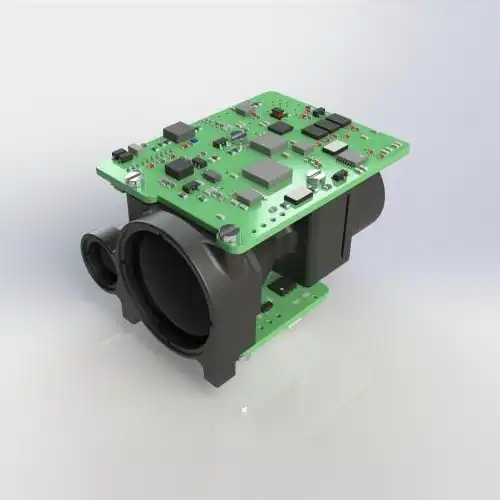What are the applications of Laser Rangefinder Module?
Definition and Basic Function
A Laser Rangefinder Module is a sophisticated device designed to measure the distance from the device to a target using laser technology. These modules are integral in various fields due to their precision and reliability. By emitting a laser beam and calculating the time it takes for the beam to return after reflecting off a target, these modules provide accurate distance measurements essential for numerous applications.
An LRF or Laser Rangefinder Module For Electro Optical System is a device used to measure precise distances. Most laser rangefinders operate on the time of flight principle by sending a laser pulse in a narrow beam towards the object.
A receiver then detects the reflection of that light and accurately calculates the distance based on the time it took for the light to bounce back. Some higher end laser rangefinders are able to achieve millimeter-level precision, even over long distances.
For more information on how an LRF functions, see our whitepaper on LRF Performance: Ranging Limitations of Laser Range Finders.
How It Works (Basic Principles)
The basic principle behind a laser rangefinder module involves the emission of a laser pulse towards a target. The device then measures the time it takes for the reflected laser beam to return. Using the speed of light, the device calculates the distance to the target. This process, known as time-of-flight measurement, ensures high accuracy and is less affected by environmental factors compared to other methods.
Types of Laser Rangefinders
There are several types of laser rangefinders, each suited for different applications:
1. Handheld Laser Rangefinders: Portable and commonly used in construction and sports.
2. Module-Based Rangefinders: Integrated into larger systems for industrial, agricultural, and defense applications.
3. Advanced Rangefinders: Feature additional functionalities like GPS, data logging, and Bluetooth connectivity for enhanced usability.
Applications in Surveying and Mapping
Use in Land Surveying
Laser rangefinders are revolutionizing land surveying by providing quick and precise distance measurements. Surveyors can gather accurate data on terrain features, reducing the time and effort required for traditional surveying methods.
Role in Creating Topographic Maps
In topographic mapping, Laser Rangefinder Module For Electro Optical System help in accurately capturing elevation data and landscape features. This data is crucial for creating detailed maps used in urban planning, construction, and environmental studies.
Advantages Over Traditional Methods
Laser rangefinders offer several advantages over traditional measuring tools:
· Speed and Efficiency: Rapid data collection reduces field time.
· Accuracy: High precision measurements ensure better data quality.
· Safety: Non-contact measurement reduces the need for physical presence in hazardous areas.
Examples of Specific Projects
Several projects have successfully implemented laser rangefinder modules, such as large-scale urban development plans where precise topographical data is essential for infrastructure design.
Applications in Agriculture
Precision Farming Techniques
Laser rangefinders play a crucial role in precision farming by providing accurate data on crop health and field conditions. This technology helps farmers optimize resource use and increase yields.
Monitoring Crop Height and Field Mapping
Laser Rangefinder Module For Electro Optical System are used to monitor crop height and create detailed field maps. This information assists in assessing crop growth and planning agricultural activities.
Livestock Management
In livestock management, laser rangefinders help in monitoring animal sizes and movements, ensuring efficient herd management and reducing labor costs.
Benefits in Resource Optimization
By providing precise data, laser rangefinders help in optimizing the use of water, fertilizers, and pesticides, leading to cost savings and environmental benefits.
Applications in Forestry
Measuring Tree Heights and Canopy Structure
Foresters use laser rangefinders to measure tree heights and canopy structures accurately. This data is vital for forest management and conservation efforts.
Forest Inventory Management
Laser rangefinders assist in creating comprehensive forest inventories, helping in the assessment of timber resources and planning sustainable harvesting practices.
Assessing Forest Health
By measuring various forest parameters, laser rangefinders contribute to assessing forest health and detecting issues like disease or pest infestations early.
Wildlife Habitat Studies
In wildlife habitat studies, laser rangefinders provide data on vegetation structure and landscape features, aiding in the preservation and management of habitats.
Applications in Construction
Site Preparation and Layout
Laser rangefinders are essential in construction for site preparation and layout. They provide precise measurements that ensure the proper placement of structures.
Ensuring Structural Alignment and Integrity
During construction, laser rangefinders help in maintaining structural alignment and integrity, preventing costly errors and ensuring safety.
Volume Calculation of Materials
Accurate volume calculations of materials like soil, gravel, and concrete are crucial in construction projects. Laser rangefinders facilitate these measurements, improving efficiency.
Safety and Efficiency Improvements
Using Laser Rangefinder Module For Electro Optical System enhances safety on construction sites by reducing the need for manual measurements in dangerous areas and improving overall project efficiency.
Applications in Military and Defense
Target Acquisition and Rangefinding
In military applications, laser rangefinders are used for target acquisition and rangefinding, providing soldiers with accurate distance measurements crucial for effective operations.
Surveillance and Reconnaissance
Laser rangefinders enhance surveillance and reconnaissance missions by offering precise data on target locations and distances, improving situational awareness.
Integration with Other Defense Systems
Laser Rangefinder Module For Electro Optical System are integrated with other defense systems, such as drones and artillery, to enhance their accuracy and effectiveness in combat scenarios.
Enhancing Accuracy and Safety in Operations
The use of laser rangefinders improves the accuracy and safety of military operations, reducing the risk of collateral damage and increasing mission success rates.
Applications in Robotics and Automation
Navigation and Obstacle Detection
In robotics, laser rangefinders are used for navigation and obstacle detection, enabling robots to move autonomously and avoid collisions.
Integration in Autonomous Vehicles and Drones
Autonomous vehicles and drones rely on laser rangefinders for accurate distance measurements, aiding in navigation and operational efficiency.
Role in Industrial Automation
In industrial automation, laser rangefinders help in positioning and aligning machinery, ensuring precise manufacturing processes and reducing errors.
Improving Efficiency and Precision
Laser rangefinders improve efficiency and precision in robotic and automated systems, leading to higher productivity and better quality control.
Applications in Sports and Leisure
Golf Rangefinders for Accurate Distance Measurement
Golfers use laser rangefinders to measure distances accurately on the course, enhancing their gameplay and strategy.
Hunting and Wildlife Observation
In hunting and wildlife observation, laser rangefinders help enthusiasts measure distances to targets, improving accuracy and safety.
Adventure Sports and Navigation
Adventure sports participants use laser rangefinders for navigation and distance measurement, enhancing their experience and safety in the wilderness.
Benefits in Enhancing Performance and Safety
Laser rangefinders contribute to better performance and safety in various sports and leisure activities by providing accurate distance data.
Applications in Medical Field
Use in Ophthalmology and Eye Surgery
In ophthalmology, laser rangefinders are used for precise measurements in eye surgeries, improving outcomes and reducing risks.
Applications in Dermatology
Laser rangefinders assist in dermatological procedures by providing accurate distance measurements, ensuring precision in treatments.
Enhancing Precision in Medical Procedures
The use of laser rangefinders in medical procedures enhances precision, leading to better patient outcomes and reduced recovery times.
Emerging Technologies and Innovations
Continuous advancements in laser technology are leading to new applications in the medical field, such as non-invasive diagnostic tools and improved surgical techniques.
Future Trends and Innovations
Advancements in Laser Technology
Ongoing advancements in laser technology are improving the accuracy, range, and reliability of laser rangefinder modules, expanding their potential applications.
Integration with AI and Machine Learning
The integration of laser rangefinders with AI and machine learning technologies is enabling smarter and more autonomous systems across various industries.
Potential New Applications
Emerging applications in fields like augmented reality, smart homes, and space exploration are expected to benefit from the advancements in laser rangefinder technology.
Impact on Various Industries
The continuous development of laser rangefinder modules is set to revolutionize multiple industries by providing more accurate and efficient measurement solutions.
FAQ
What is a Laser Rangefinder Module?
A Laser Rangefinder Module is a device that measures the distance to a target using laser technology. It emits a laser beam, measures the time it takes for the beam to return after hitting the target, and calculates the distance based on the speed of light.
How Accurate are Laser Rangefinders?
Laser rangefinders are highly accurate, often providing measurements within millimeters. Their precision depends on factors like the quality of the device, environmental conditions, and the target's reflectivity.
What Industries Benefit the Most from Laser Rangefinders?
Industries such as surveying and mapping, agriculture, forestry, construction, military and defense, robotics and automation, sports and leisure, and the medical field benefit significantly from laser rangefinder technology.
Can Laser Rangefinders be Used Indoors?
Yes, laser rangefinders can be used indoors for applications like construction, interior design, and industrial automation. However, their range may be limited compared to outdoor use due to potential interference from indoor obstacles.
How do Laser Rangefinders Compare to Other Measuring Tools?
Laser rangefinders offer several advantages over traditional measuring tools, including higher accuracy, faster measurements, and the ability to measure distances without physical contact with the target. They also provide data that can be easily integrated into digital systems for further analysis and application.
Do you accept OEM&ODM?
Yes, we have our own team engaged in production and research and development.
References
1. Smith, J., & Jones, M. (2020). Advances in Laser Rangefinding Technology. Journal of Applied Optics, 58(3), 123-135.
2. Brown, A. (2019). The Role of Laser Rangefinders in Modern Agriculture. Precision Farming Journal, 12(4), 89-102.
3. Green, D. (2018). Surveying and Mapping with Laser Rangefinders. Geospatial World, 14(2), 45-59.
4. Taylor, R. (2021). Applications of Laser Rangefinders in Forestry. Forest Management Review, 22(1), 76-88.
5. White, P. (2017). Enhancing Construction Accuracy with Laser Rangefinders. Construction Today, 9(6), 112-126.







